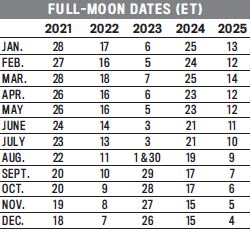ASTRONOMY
ECLIPSES
There will be four eclipses in 2021, two of the Sun and two of the Moon. Solar eclipses are visible only in certain areas and require eye protection to be viewed safely. Lunar eclipses are technically visible from the entire night side of Earth, but during a penumbral eclipse, the dimming of the Moon's illumination is slight. See the Astronomical Glossary, page 110, for explanations of the different types of eclipses.

MAY 26: TOTAL ECLIPSE OF THE MOON. This eclipse is only partially visible from North America. The best views will be from western North America; and the eclipse also will be visible from Hawaii. The Moon will enter the penumbra at 4:46 a.m. EDT (1:46 a.m. PDT) and umbra at 5:45 a.m. EDT (2:45 a.m. PDT). It will leave the umbra at 8:53 a.m. EDT (5:53 a.m. PDT) and penumbra at 9:51 a.m. EDT (6:51 a.m. PDT).
JUNE 10: ANNULAR ECLIPSE OF THE SUN. This eclipse is visible from northern and northeastern North America, beginning at 4:12 a.m. EDT and ending at 9:11 a.m. EDT. The time of maximum eclipse varies by location. Note that this is an annular eclipse; the Moon will never fully obscure the visible surface of the Sun: At maximum eclipse, an "annulus" (ring) of full sunlight will still be visible. It is safe to view this eclipse only when using eye protection such as "eclipse glasses" or a solar filter.
NOVEMBER 18–19: PARTIAL ECLIPSE OF THE MOON. This eclipse is visible from North America and Hawaii. The Moon will enter the penumbra at 1:00 a.m. EST on November 19 (10:00 p.m. PST, November 18) and umbra at 2:18 a.m. EST on November 19 (11:18 p.m. PST, November 18). It will leave the umbra at 5:47 a.m. EST (2:47 a.m. PST) and penumbra at 7:06 a.m. EST (4:06 a.m. PST) on November 19.
DECEMBER 4: TOTAL ECLIPSE OF THE SUN. This eclipse is not visible from North America. (It will be visible from the Falkland Islands, the southern tip of Africa, Antarctica, and southeasternmost Australia.)
TRANSIT OF MERCURY. Because of Mercury's proximity to the Sun, the planet can be seen for only a few weeks before and after times of greatest elongation. It is observable near greatest eastern elongation during evening twilight and near greatest western elongation during morning twilight. In 2021, Mercury is best viewed from the Northern Hemisphere after sunset during the last 3 weeks of January and all of May. Look for a conjunction between Mercury and Jupiter on the morning of March 5, between Mercury and Venus on the evening of May 28, and between Mercury and Mars on the evening of August 18.
THE MOON'S PATH The Moon's path across the sky changes with the seasons. Full Moons are very high in the sky (at midnight) between November and February and very low in the sky between May and July.
